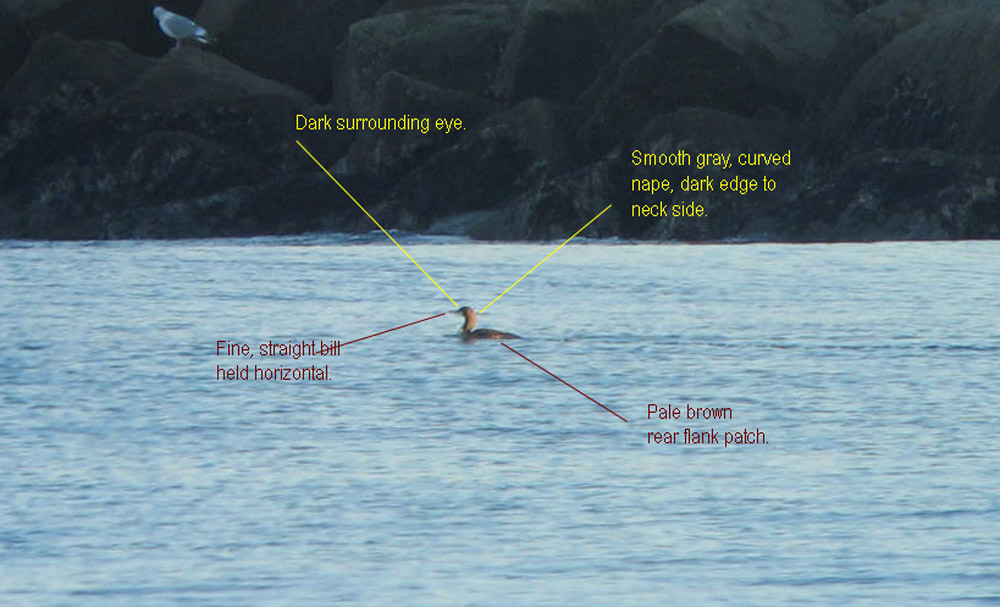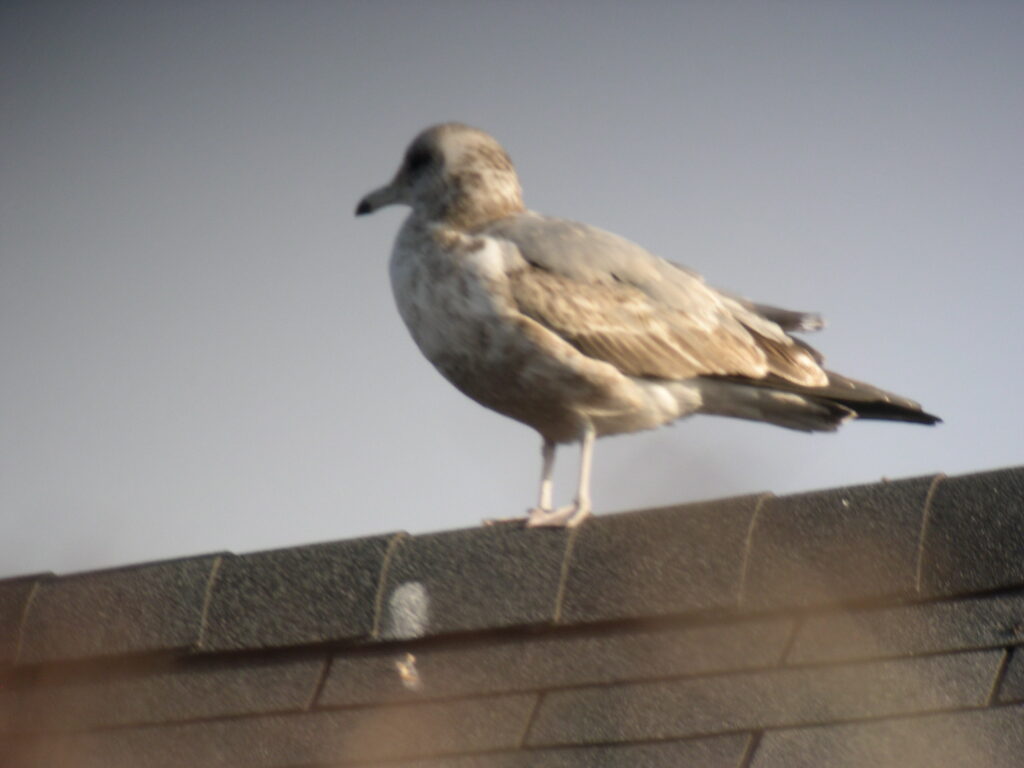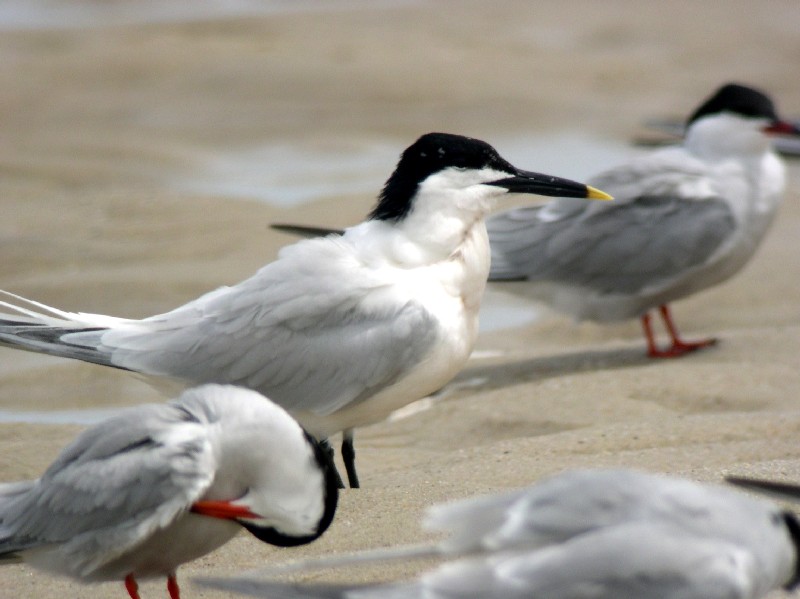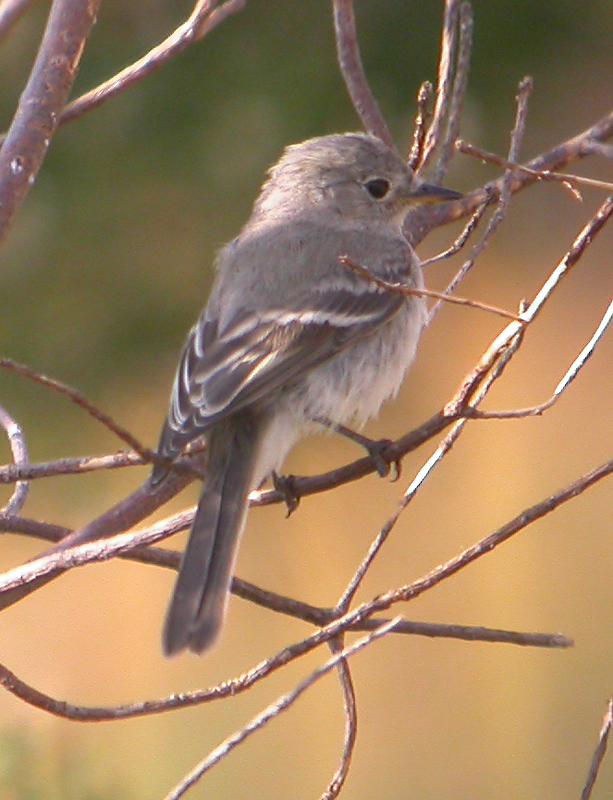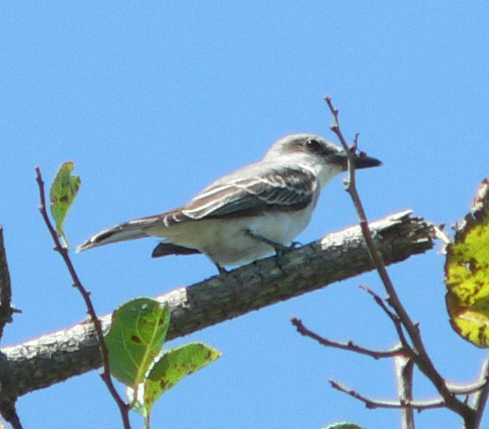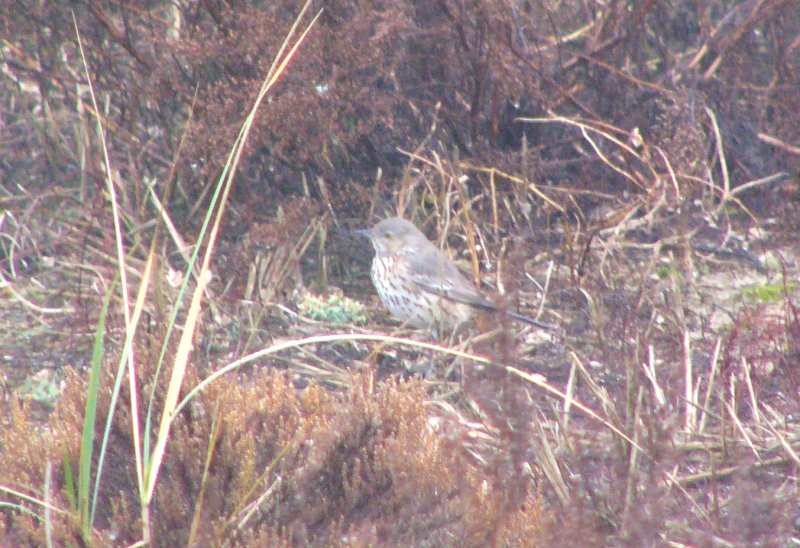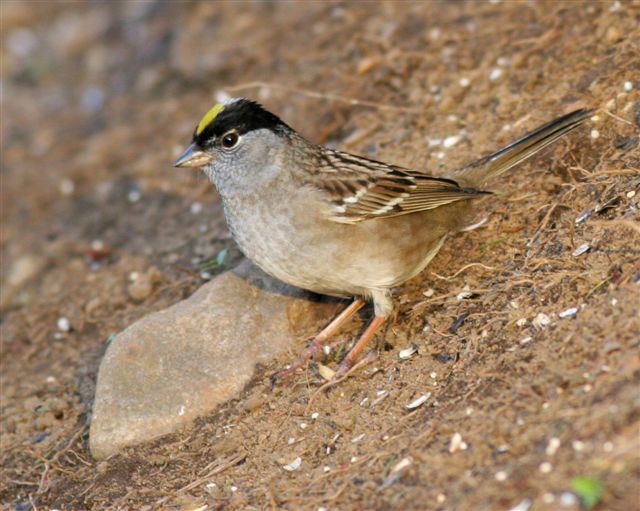ELEVENTH ANNUAL REPORT OF THE MASSACHUSETTS AVIAN RECORDS COMMITTEE
by Marjorie Rines, Secretary
originally published in Bird Observer (April 2007)
Since the last MARC Annual Report, one new species has been added to the official State List: Eurasian Collared-Dove. Although the MARC has received several earlier reports of this species, none could satisfactorily rule out the very similar the Ringed Turtle-Dove, a species commonly kept in captivity. This brings the total on the official state list to 485 [author’s note, originally published incorrectly as 484 species] species.
Cackling Goose (Branta hutchinsii), #06-30, October 25, 2006, Plum Island (Essex), Tom Wetmore*. In the 45th Supplement to The American Ornithologists’ Union Check-list of North American Birds, Sixth Edition, Canada Goose was split into two species: Canada Goose (B. canadensis) and Cackling Goose (B. hutchinsii). Prior to that time, there were very few reports of the smaller hutchinsii race for Massachusetts; however, since being elevated to full species status, state reports have increased dramatically. (First Ballot: Vote: 8-1)
Pacific Loon (Gavia pacifica), #05-48, December 11, 2005, Salisbury (Essex), J. P. Smith*†. Although this species is practically routine in winter, the species remains on the Review List due to identification difficulties. Pacific Loons can easily be confused with Common and Red-throated Loons and great caution should be used when making this identification. This record was supported by identifiable photographs. (First ballot: Vote: 9-0)
Western Grebe (Aechmophorus occidentalis), #05-56, November 25, 2005, Plum Island (Essex), Karsten Hartel*. The initial observer carefully described an Aechmophorus grebe, but was unable to get a sufficiently good look to positively eliminate Clark’s Grebe (A. clarkii ). Later in the day that the grebe was discovered, a second observer was able to relocate the bird and confirmed that the bird had the dark cap surrounding the eye, dull bill, and all dark back that distinguishes Western Grebe. Although Clark’s Grebe has never been recorded in Massachusetts, one was recorded in Maine in 2005 as a first New England record. (First ballot: Vote: 8-1)
Yellow-nosed Albatross (Thalassarche chlororhynchos), #06-09, May 14, 2006, Barnstable (Barnstable), G. Hirth* (First ballot: Vote: 8-1). #06-21, June 6, 2006, Rockport, Andrews Pt (Essex), R. Heil*. (First ballot: Vote: 9-0). In mid-May 2006, a week of northeastly winds culminated in a miserable weekend with winds gusting to 40 MPH. Sea watchers along the coast were treated to a fine display of pelagic species, but the bird of the storm was unequivocally an adult Yellow-nosed Albatross spotted at Sandy Neck in Barnstable. Three weeks later, during conditions apparently unaffected by weather, a sea-watcher at Andrew’s Point in Rockport was astonished to see an adult Yellow-nosed Albatross being pursued by a group of very vocal Herring and Great Black-backed gulls as it flew along the rocky shoreline. . It is possible that these two sightings may have involved the same individual albatross.
Black-capped Petrel (Pterodroma hasitata), #05-38, October 25, 2005, Rockport (A.P.) (Essex), R. Heil*, B. Kane*. During an intense nor’easter an experienced sea-watcher conducting a migration study at Andrews Point in Rockport was shocked to observe a Black-capped Petrel. The bird was in view for roughly two minutes, and was able to be observed in direct comparison with a Greater Shearwater. Although this species is regularly seen on the continental slope south of New England, it represents only the fourth Massachusetts record, and the second from land. The first land-based sightingwas on August 19, 1991 off South Sunken Meadow Beach in Eastham during Hurricane Bob. (First ballot: Vote: 9-0)
White Ibis (Eudocimus albus), #04-19, August 4, 2004, Beverly (Essex), J. Paluzzi*. (Third ballot: Vote: 8-1). #06-18, April 1, 2006, Scituate (Plymouth), C. Nims*† (First ballot: Vote: 9-0). Alhough regularly reported north to Virginia, this species is prone to northward dispersal. Although the Beverly ibis was only observed from a moving car, it flew directly overhead affording the observer a definitive view of this distinctive species. The Scituate bird was observed for 15 minutes and photographs accompanied the report.
Swallow-tailed Kite (Elanoides forficatus), #06-12, May 20, 2006, Wellfleet (Barnstable), E. Olsen, D. Berard*. Swallow-tailed Kites rarely linger long enough for secondary observers to see them, but in this case the bird was seen and described by a group visiting the discovery location two hours after the initial observation. (First ballot: Vote: 9-0)
Yellow Rail (Coturnicops noveboracensis), #06-25, October 8, 2006, Newbury (Essex), R. Lockwood*, P. Brown†. Undoubtedly far more common in Massachusetts than is suggested by existing records, the elusive nature of Yellow Rails makes them exceptionally difficult to find. This remarkably cooperative bird was observed for fifteen minutes by the original observer, then was relocated and photographed by later observers. (First ballot: Vote: 9-0)
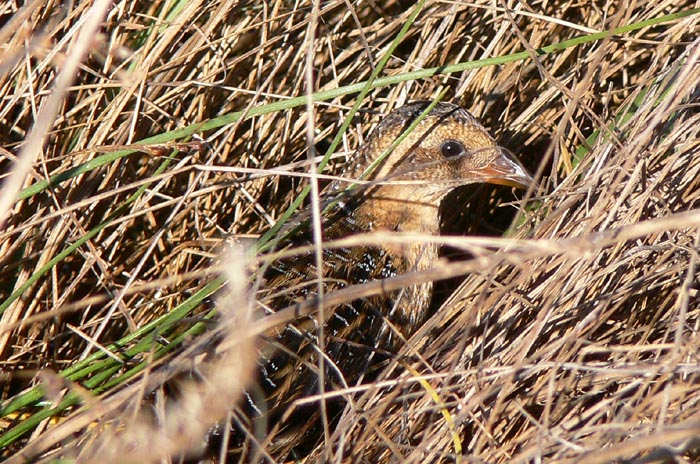
8 October 2006 Plumbush Marshes, Newburyport. Photo by Phil Brown
Purple Gallinule (Porphyrula martinica), #05-34, November 3, 2005, Holyoke (Hampden), A. + L. Richardson*†. An infrequent vagrant from the south, this bird was a juvenile, as is typically the case with fall occurrences of this species. (First ballot: Vote: 9-0)
Willet (Catoptrophorus semipalmatus), #06-15, May 13, 2006, Petersham (Worcester), M. Lynch and S. Carroll*. Grim, rainy weather forced a number of typically coastal birds to appear inland at on this date. In addition to the Willet the observers recorded five Common Terns and a Caspian Tern. This observation represents the first inland record of this species in Massachusetts. (First ballot: Vote: 9-0)
Black-tailed Godwit (Limosa limosa), #06-17, July 17-29, 2006, Plum Island (Essex), Phil Brown† et al. Although no written report was submitted for this report, the bird was observed and photographed by many people during its two-week stay. The bird was suspected by some observers to be the nominate European race L. l. limosa, rather than the more expected Icelandic race, L. l. islandica. Because of the difficulty in separating these races in the field, the racial identity of this bird is best left as indeterminate. This was the fourth record for Massachusetts. (First ballot: Vote: 9-0)
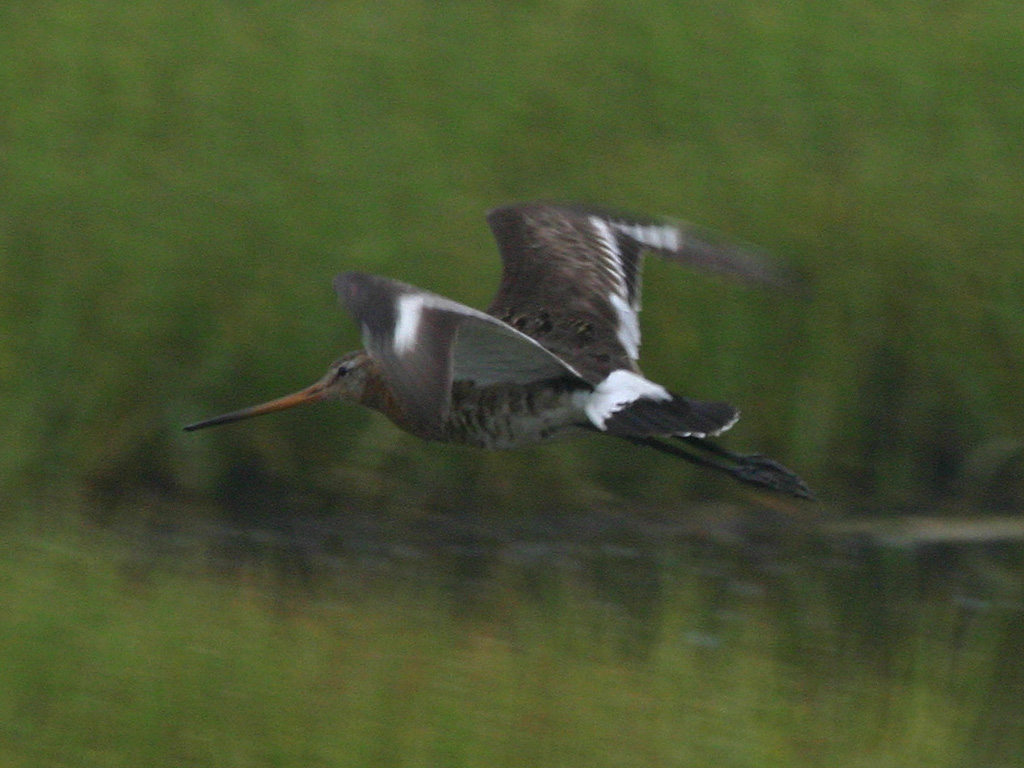
Photo by E. Nielsen.
Red-necked Stint (Calidris ruficollis), #06-26, July 12, 2006, Dorchester (Suffolk), R. Donovan*. A stint in breeding plumage discovered along the Neponset River at high tide, was never able to be relocated once the tide fell that day. (First ballot: Vote: 9-0)
Franklin’s Gull (Larus pipixcan), #05-33, November 8-12, 2005, Turners Falls (Franklin), J. Smith†, S. Smolen-Morton* (First ballot: Vote: 9-0). #05-43, October 29, 2005, Rockport (A.P.) (Essex), Rick Heil* (First ballot: Vote: 9-0). #05-46, November 1, 2005, Ipswich (Essex), Rick Heil* (First ballot: Vote: 9-0). #05-54, November 26-December 13, 2005, Wellfleet (Barnstable), S. Jaffe, B. Nikula*†. (First ballot: Vote: 9-0). #06-03, May 23, 2006, Newburyport (Essex), Richard Veit* (First ballot: Vote: 9-0). Although a somewhat regular vagrant to Massachusetts, Franklin’s Gulls typically appear only every few years, however in the fall of 2005 there was a virtual irruption of this species. The MARC Tenth Annual Report included two Franklin’s Gull reports for August, and in the months following there were an additional four individuals reported to the Committee, and another was reported in May of 2006. All of these individuals were sub-adults, in either first or second-winter plumage. Of particular interest was the individual that spent a month at Turners Falls in Montague (Franklin), since inland reports in Massachusetts are notably rare.
California Gull (Larus californicus), #06-01, January 1, 2006, Nantucket (Nantucket), B. Harris*†. A California Gull in second-winter plumage was discovered at Miacomet Pond on Nantucket on New Years Day, exactly one year after a first-winter individual was discovered only three miles away in 2005. Prior to 2005 there were only two records of this species in Massachusetts. (First ballot: Vote: 9-0)
Bridled Tern (Onychoprion anaethetus), #05-39, June 11, 14, 2005, Marion (Plymouth), I. Nisbet*. Initially spotted flying low over Bird Island, occasionally being harassed by Common Terns, this bird briefly landed once on the island before flying south down Buzzards Bay. The same observer noted a Bridled Tern at precisely the same location almost exactly 10 years previously, on June 8, 1995. (First ballot: Vote: 8-1)
Sandwich Tern (Thalasseus sandvicensis), #06-07, June 12, 2006, South Monomoy (Barnstable), B. Harris†. #05-55, October 30, 2005, North Truro (Barnstable), David Spang*. (Second ballot: Vote: 8-1). Most reports of this species occur in the summer, so the individual observed in late October was exceptional. (First ballot: Vote: 9-0)
Long-tailed Jaeger (Stercorarius longicaudus), #06-24, August 8, 2006, Stellwagen Bank, D. Berard*. Well described and closely observed, the observer was fortunate to be able to view this bird in direct comparison with both Parasitic and Pomarine jaegers. (First ballot: Vote: 8-1)
Eurasian Collared-Dove (Streptopelia decaocto), #05-08, May 28, 2005, Ipswich (Essex), A. Richards*, J. Doppler*, et al. The Eurasian Collared-Dove made its way to the United Stated via the Bahamas, where it was first introduced in the 1970s. Once the species arrived in Florida, it rapidly took hold and began to spread north. A first appearance has been expected in Massachusetts for a number of years, but prior to this report, previous sighting have never satisfactorily eliminated the very similar Ringed Turtle-Dove (S. risoria), a feral species of uncertain ancestry that is commonly kept in captivity. This report was troublesome to the Committee because the observers were unable to clearly see several important field marks, particularly the gray undertail coverts and dark at the bases of the outer rectrices. Fortunately, however, the dove vocalized, clearly giving, “a three note call of coo-like notes. The first two notes were similar to each other and the third note was different and somewhat delayed.” Several of the observers were familiar with this call from previous experience, and at once recognized it for what it was. The vocalization information is what convinced the Committee of the correctness of the identification. This is a first state record. (Third ballot: Vote: 8-1)
White-winged Dove (Zenaida asiatica), #06-14, April 4-28, 2006, Manchester (Essex), T. Grady†. Feeder watchers in Manchester noticed two unusual-looking doves at their feeder in early April, but unfortunately did not report the birds until one was killed and the other bird had disappeared. Marginal digital photographs documented one of the birds, but because there were no written details, only the photographed bird was accepted. (First ballot: Vote: 9-0)
Black-chinned Hummingbird (Archilochus alexandri), #06-20, August 6, 2006, Brewster (Barnstable), S. Finnegan (banded)*†. This bird was fortuitously captured by a bird-bander, who immediately recognized it as a male Black-chinned Hummingbird. She was able to obtain detailed measurements as well as definitive photographs of the bird in the hand. Vagrant hummingbirds are typically discovered in late fall when they are reported coming to feeders, so this early August record makes it interesting to speculate upon how many may be overlooked each summer. This represents only the second record of this species in Massachusetts, the first being an individual discovered in a Cohasset greenhouse in November of 1979. (First ballot: Vote: 9-0)
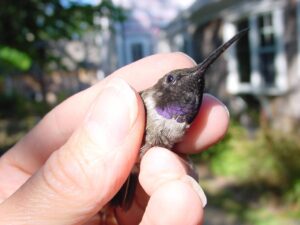
Photo by S. Finnegan.
Rufous Hummingbird (Selasphorus rufus), #06-27, October 28-December 30, 3006, Cotuit (Barnstable), T. Burgess*† S. Finnegan (banded) *†. (First ballot: Vote: 9-0). #06-28, October 15-November 16, 2006, Dennis (Barnstable), S. Finnegan (banded) *†. (First ballot: Vote: 9-0). #06-35, November 17, 2006, Cataumet (Barnstable), S. Finnegan (banded) *† (First ballot: Vote: 8-1). The fall of 2006 produced a flood of reports of vagrant hummingbirds, including records of no fewer than three Rufous Hummingbirds, all of which were banded, measured, and photographed.
Selasphorus Species, #06-19, April 22-27, 2006, North Orange (Franklin), Rachel Scherer*†. Selasphorus hummingbirds have become practically routine in the fall, but this male in practically adult plumage is only the second spring record of a non-captive bird. (A Rufous Hummingbird spent several winters in a Northampton greenhouse with permission of MassWildlife, however its release in the spring constitutes a spring record of non-natural occurrence.) Photographs of the North Orange hummingbird suggested Rufous, but could not positively eliminate Allen’s Hummingbird (S. sasin). (First ballot: Vote: 9-0)

Photo by R. Scherer.
Gray Flycatcher (Empidonax wrightii), #06-36, November 5-6, 2006, Cambridge (Middlesex), J. Trimble*† et al. Fall Empidonax flycatchers often go unidentified unless they are captured and measured; however, Gray Flycatcher is readily identifiable in the field, not only by plumage, but also by its feeding behavior and distinctive downward tail pumping. Written documentation accompanied by numerous photographs made the identification of this individual unambiguous. Extraordinarily, a Least Flycatcher (E. minimus) frequenting the same area as the Gray Flycatcher, caused considerable confusion for a number of observers until it was determined that two species were actually present. This is only the second state record for this species, the first being a bird collected in Littleton on October 31, 1969. (First ballot: Vote: 9-0)
Ash-throated Flycatcher (Myiarchus cinerascens), #05-37, November 6-14, 2005, Plum Island (Essex), P. Brown†, C. Marantz*. In the past decade this species has become almost annual in Massachusetts in fall. This individual was definitively photographed and described, clearly eliminating possible confusion with other Myiarchus flycatchers. (First ballot: Vote: 9-0)
Western Kingbird (Tyrannus verticalis), #06-13, June 14, 2006, Wellfleet (Barnstable), D. Berard*. Western Kingbird is not on the MARC review list, but it is extremely rare in spring, so the Committee reviewed this report. (First ballot: Vote: 9-0)
Gray Kingbird (Tyrannus dominicensis), #06-23, September 7-8, 2006, Aquinnah (Dukes), P. Gilmore*, L. McDowell†. The original observer had no experience with this species, but readily identified it from his field guide. The following day he rediscovered it for additional observers who were able to obtain conclusive photos. Although this species, is very rare north of South Carolina at any season, Gray Kingbirds occasionally stray northward in the fall and have been recorded at many locations north along the Atlantic coast to Massachusetts and has even been found in New Brunswick and Nova Scotia. This is only the fourth state record of this species, the last being almost exactly 18 years before on September 9, 1988, only a few miles away at Squibnocket. (First ballot: Vote: 9-0)
Cave Swallow (Petrochelidon fulva), #05-44, November 11, 2005, Barnstable (Barnstable), Mary Keleher (First ballot: Vote: 9-0). #05-45, November 12, 2005, Acoaxet (Bristol), Mark Lynch and Sheila Carroll (First ballot: Vote: 9-0).#05-35, November 10-11, 2005, Lynn Beach (Essex), L. Pivacek, R. Stymeist (First ballot: Vote: 9-0). #05-36, November 21, 2005, Swampscott (Essex), L. Pivacek (First ballot: Vote: 9-0). #06-34, 11/18/06, Plum Island (Essex), Tim Spahr. (First ballot: Vote: 9-0). The first record of Cave Swallow in Massachusetts was in 2003. In 2005, only two years later, there were multiple sightings of birds reported from coastal several locations. In 2006, however, only a single bird was reported.
Northern Wheatear (Oenanthe oenanthe), #06-05, May 30-31, 2006, Nantucket. (Nantucket), Edie Ray (First ballot: Vote: 9-0). #06-06, May 25, 2006, Dennis (Barnstable), C. Walz. (First ballot: Vote: 9-0). This species is a very rare and irregular fall visitor, with multiple birds occasionally appearing in some years; but spring records are even more unusual. Both of these spring reports pertained to birds that were discovered on outer beaches, a habitat in Massachusetts where these rare northern breeders are most often found.
Townsend’s Solitaire (Myadestes townsendi), #05-50, November 5-December 18, 2005, North Truro (Barnstable), B. Nikula, P. Trull et al. (First ballot: Vote: 9-0). #05-51, December 27, 2005, Barnstable (Barnstable), M. Keleher et al. (First ballot: Vote: 8-1). The appearance of even a single Townsend’s Solitaire in Massachusetts is always unexpected, but finding two together is unprecedented. Observers in Truro first finding the solitaires kept seeing a single bird appear repeatedly, assuming it was the same individual each time it was seen, until it called and a second bird joined it and both perched on utility wired only 20-25 feet apart! At least one of these two birds lingered until the Truro CBC on December 27. The same day, on the Mid-Cape CBC, a group of three observers discovered another solitaire in Barnstable.
Sage Thrasher (Oreoscoptes montanus), #05-49, November 6, 2005, Plum Island (Essex), T. Spahr*†, M. Durgin*. The observer who discovered this bird described catching sight of it from his car, and immediately realized it was something different. Fortunately he was able to readily relocate the bird as it foraged in a parking lot, where he was able to watch and videotape the bird for ten minutes. This is only the second state record for this western vagrant, the first also occurring at Plum Island on October 26, 1965. (First ballot: Vote: 9-0)
Black-throated Gray Warbler (Dendroica nigrescens), #06-33, November 19, 2006, Falmouth (Barnstable), John Liller*† et al. Brief but convincing details accompanied a photograph of this rare western warbler. (First ballot: Vote: 9-0)
Townsend’s Warbler (Dendroica townsendi), #05-52, December 11-15, 2005, Marstons Mills (Barnstable), J. Hoye* et al. This bird was discovered among a remarkable flock of over wintering warblers that included Orange-crowned, Yellow, Palm, and Black-and-white warblers, and American Redstart. (Second ballot: Vote: 8-1)
MacGillivray’s Warbler (Oporornis tolmiei), #05-47, November 1, 2005, Ipswich (Essex), Rick Heil. There are only a dozen records of this warbler in Massachusetts, almost all of which appeared in late fall when Mourning Warblers have vacated the state, a clear reminder that any late fall Oporornis should be checked carefully for this species. (First ballot: Vote: 9-0)
Green-tailed Towhee (Pipilo chlorurus), #06-32, October 31-November 17, 2006, Plum Island (Essex), J. Standley (banded), D. Larson†. Although the Committee received no written report of this bird, it was extensively photographed and the images have been catalogued. (First ballot: Vote: 9-0)
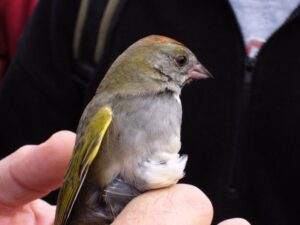
Photo by D. Larsen.
Golden-crowned Sparrow (Zonotrichia atricapilla), #06-02, April 26, 2006, Sturbridge (Worcester), R. Cormier, I. lynch*, M. Lynch*, R.Merrill†, B. deGraaf†. This rare western vagrant was well photographed and described. (First ballot: Vote: 9-0)
Hoary Redpoll (Carduelis hornemanni), #04-39, March 12, 2004, Williamsburg (Hampshire) G. LeBaron*. Distinguishing between redpolls is notoriously difficult because of plumage similarities in Common and Hoary redpolls. This report, however, clearly described the pale, unstreaked rump and undertail coverts that are characteristic of this species, as well as the diminutive bill that is a hallmark of Hoary Redpoll. Not surprisingly, there was a major irruption of both species of redpoll in the winter of 2003-2004. (Third ballot: Vote: 9-0)
Not Accepted
Cackling Goose (Branta hutchinsii), #05-41, November 21, 2005, Winthrop (Suffolk). Although this bird was clearly a small goose, the description could not rule out one of the smaller forms of Canada Goose, such as B. c. parvipes. (Second ballot: Vote: 4-5)
White-tailed Hawk (Buteo albicaudatus), #06-04, April 22-24, 2006, Hadley (Hampshire). This much-photographed bird was clearly a White-tailed Hawk, but the Committee ultimately did not accept this record because of questions about its origin. This is generally a sedentary, non-migratory species, restricted in the United States to southern and coastal Texas, with no eastern records beyond coastal Louisiana. The bird was discovered in a field next to a facility where falcons were kept, although the falconer did not, in fact, possess a White-tailed Hawk and other falconers consulted knew of no White-tailed Hawks being kept in captivity. The Committee’s decision was complicated by the fact that on April 25 a White-tailed Hawk was observed near Baskin Ridge, New Jersey, and on April 27, another was seen at the Pilgrim Heights hawk watch in North Truro, Massachusetts. The Committee decided that although the facts of this sighting were extremely suggestive of wild origin, the sedentary nature of this species weighed too strongly against the possibility of a sudden irruption. While it is very rare to unknown in captivity, there are nonetheless people who illegally keep captive raptors, and the possibility of such a bird escaping or being released could not be ruled out. (First Ballot: Vote: 3-6).
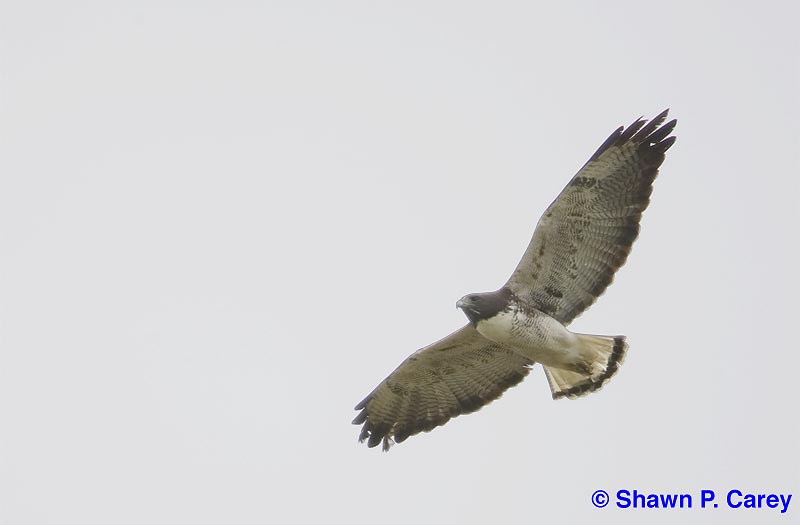
Photo by Sean Carey
Black Rail (Laterallus jamaicensis), #06-29, November 11, 2006, Nantucket (Nantucket). An all-dark rail flushed from the Quaise Marsh on Nantucket afforded the viewer too short a view to positively confirm all field marks, and the Committee felt that the description could not eliminate other species of rail. (First ballot: Vote: 0-9)
Baird’s Sandpiper (Calidris bairdii), #06-10, May 18, 2006, Natick (Middlesex). This report was extremely suggestive of Baird’s Sandpiper, but the description of a buffy breast and scaly back were not consistent with spring plumage. There is no spring record for this species in Massachusetts, so the Committee took a conservative stance and did not accept the report. (Second ballot: Vote: 2-7)
California Gull (Larus californicus), #06-08, June 3, 2006, South Boston (Suffolk). This adult gull was seen in poor weather, making it impossible for the observer to note some key field marks, such as eye color and bill pattern. While the Committee believed that the bird might have been a California Gull, they also believed the report could not conclusively rule out other species. The late date for an adult bird was also troublesome to some members of the Committee. (Second ballot: Vote: 2-7)
Yellow-bellied Flycatcher (Empidonax flaviventris), #05-53, November 4, 2005, Brewster (Barnstable). An Empidonax flycatcher with a very green back and yellow belly was captured by a bander on November 4. The date was very suspect for Yellow-bellied Flycatcher, but the p10 to p5 measurements were inconsistent with the most likely candidate, one of the “Western” Flycatcher complex (Pacific-coast Flycatcher, E. difficilis and Cordilleran Flycatcher, E. occidentalis). Based on measurement, it was submitted to the MARC as Yellow-bellied, but experts agreed there were too many anomalies to make a definitive decision. (First ballot: Vote: 4-5)
Black-throated Gray Warbler (Dendroica nigrescens), #05-40, October 1, 2005, Chilmark (Dukes). Although the Committee felt the observer had likely seen a Black-throated Gray Warbler, the details were insufficient to rule out other species. (First ballot: Vote: 3-6)
Current members of the MARC are Dennis Abbott, David Clapp, Davis Finch, Richard Heil, Erik Nielsen, Blair Nikula, Robert Stymeist, Scott Surner, and Jeremiah Trimble (Chair). Marjorie Rines is Secretary.
* Details submitted
† Photographs submitted or obtained on the Internet
The author thanks Wayne Petersen and Jeremiah Trimble for editorial assistance.

